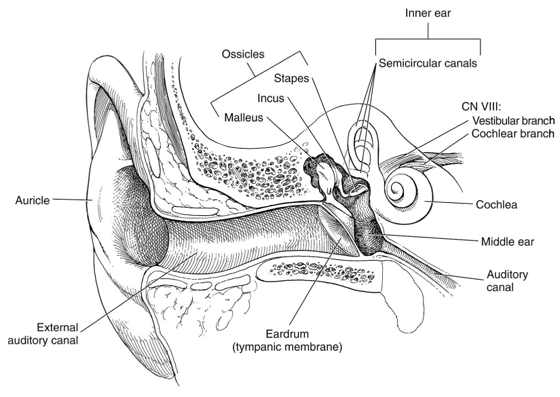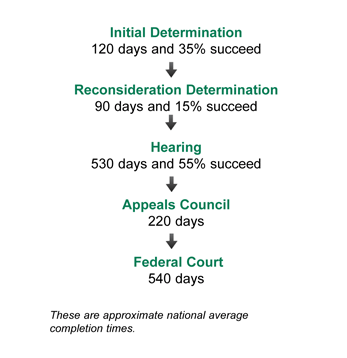The Social Security Disability Hearing
A Social Security disability hearing is held in front of an administrative law judge (ALJ). It is much less formal than a court hearing, and is non-adversarial. That is, there is no lawyer representing the Social Security Administration who appears to present SSA’s side. Indeed, SSA claims that it doesn’t have a “side.” The agency views its role as providing benefits to those claimants who are disabled and denying benefits to those who are not. It is the ALJ’s job, as a neutral fact-finder working for a neutral agency, to inquire fully into the disability issues and find the claimant disabled if the claimant meets the requirements for disability set forth in the Social Security Act.
For the most part, ALJs fulfill the neutral fact-finder role, granting disability benefits to about 60 percent of all claimants who appeal to the hearing level. There are, of course, individual differences among ALJs. While all ALJs view themselves as neutral fact-finders, some are harder to convince than others. Some have low approval rates, while others are quite generous.
When preparing a case for any ALJ, your attorney will gather and submit medical records, medical opinions and other documentary evidence before the hearing (and after the hearing, if necessary), present witnesses’ testimony at the hearing and examine witnesses called by the ALJ (cross-examining them, if necessary), and present the your case in its best light to show that you are disabled under the law. It is part of your attorney’s job to avoid treating the ALJ as an adversary, even when your lawyer is arguing that the ALJ is wrong about the law or facts. In fact, opportunities to present an argument to an ALJ arise more often with the very good judges, the ones who will tell you when they have a problem with a particular aspect of your case. They tell your attorney this in order to give your attorney the opportunity to argue for your position. Even with judges who are more difficult to convince, it does not help for your attorney to treat a judge as an adversary.
You may appear in person before the ALJ or by video teleconferencing, though you are not required to appear by video if you do not want to. At a hearing before an ALJ, evidence may be received even though it would not be admissible in court under the rules of evidence used by courts. Strict deadlines for submitting evidence generally do not apply, though more deadlines are coming to this area of practice. Even so, if your attorney is having trouble getting particular evidence, he or she can ask the ALJ to issue a subpoena for the evidence or ask for additional time to obtain it and submit it after the hearing, if necessary.
Vocational experts (VEs) or medical experts (MEs) may testify, appearing in person, by video teleconferencing, or sometimes by telephone. VEs testify in nearly 60 percent of all hearings. MEs testify in somewhat fewer than 20 percent. Such experts are supposed to be neutral, too, unlike, for example, experts in worker’s compensation or personal injury cases, where everyone expects the experts to take sides. Of course, when a medical expert appears who is used to testifying for insurance companies in worker’s compensation cases, you are not likely to get much help on the case from the ME. Although an ME’s testimony alone can win a case for you (by demonstrating that your impairments meet or equal an impairment found in SSA’s Listing of Impairments), it is less likely that an ME’s testimony will be the sole reason you lose.
On the other hand, a vocational expert’s testimony can be the sole reason you lose a disability case. Although VEs also view themselves as neutral, neutrality is not the issue. VEs have been given a nearly impossible role by SSA, one that is at the very edge of their expertise. A vocational expert’s real expertise usually involves job placement for people with physical or mental limitations. VEs’ jobs often include encouraging employers to accommodate disabilities, which SSA says is not relevant to the disability determination process because SSA is concerned with how jobs are ordinarily performed in the economy, not with whether an employer might be willing to alter job duties to accommodate a limitation. SSA expects a VE to be familiar with the Dictionary of Occupational Titles, which most VEs have stopped using in their regular jobs because it is outdated. And SSA expects a VE to be able to tell an ALJ how many jobs exist in the economy for people with certain limitations, which is not something they do in their regular jobs and which requires a lot of guess work.
Most VEs view their role as giving the ALJ options — that is, they provide a basis for a denial decision and a basis for a favorable decision. VEs say they help ALJs find the line between who is disabled and who is not. However, it is a rare VE who will challenge an ALJ’s preconceived notion about a case.
If the VE draws the line correctly between those who are disabled and those who are not, your attorney’s job is to make sure you are on the disabled side of the line. This is not something done by cross-examining a VE. This is done by your attorney presenting convincing evidence about your residual functional capacity. If the ALJ does not include enough limitations in hypothetical questions to the VE, your attorney’s job is to ask additional questions that include all your limitations so that the line can be drawn between the disabled and not disabled. If the VE draws the line incorrectly, your attorney must deal with that VE testimony (through cross examination or obtaining a rebuttal VE opinion) in order to redraw the line.
Sometimes at the conclusion of a hearing, an ALJ will issue an oral bench decision setting forth findings of fact and conclusions of law establishing that you are disabled. Then, within a few days, you will receive a short summary of the decision, which is the official favorable decision from which benefits are paid.
Otherwise, after the hearing, a full written decision will be issued by the administrative law judge. Although ALJs have no time limits for issuing decisions, because of the backlog at hearing offices, ALJs are under pressure from SSA to issue decisions expeditiously. Most ALJs do so, though a few do not.
When an ALJ does not issue a bench decision at the hearing, the ALJ usually will not tell your attorney whether you won or lost. Sometimes, though, it is obvious — such as when an ALJ stops a hearing without taking testimony from a vocational expert after a medical expert testifies that your impairment meets or equals an impairment found in the Listing of Impairments.
Social Security Hearing Procedure
The Social Security regulations do not describe hearing procedure in much detail. They provide that “[a]t the hearing, the administrative law judge looks fully into the issues, questions [the claimant] and the other witnesses, and accepts as evidence any documents that are material to the issues.”
The ALJ “may receive evidence at the hearing even though the evidence would not be admissible in court under the rules of evidence used by the court.”
Witnesses will testify under oath and the ALJ will allow parties to question witnesses. The ALJ may decide when the evidence will be presented and when the issues will be discussed.
Each ALJ conducts a hearing somewhat differently from every other ALJ. An individual ALJ may use different procedures when conducting a hearing involving an unrepresented claimant than those used in a hearing when an experienced attorney is representing the claimant. For example, the length and content of opening statements by ALJs vary greatly, as does the degree to which an ALJ questions the claimant, and whether the ALJ questions the claimant before or after the claimant’s attorney asks questions. Some ALJs ask witnesses to remain in the waiting room while the claimant testifies; others do not.
There are, however, broad similarities in the way disability hearings are conducted around the country because, to one degree or another, individual ALJs follow procedures set forth in the Social Security Administration manual called HALLEX.
ALJ’s Opening Statement
In a typical hearing, the administrative law judge will open the record, state who is present and note that your attorney is representing you. The ALJ may ask your attorney or you to verify that fact on the record. Most ALJs will make some effort at the beginning of the hearing to put you at ease.
The following may be part of an opening statement by the ALJ:
1. A statement of the de novo nature of the hearing and that the ALJ is not part of the office that previously denied the claim.
2. An explanation that a recording of the proceeding is being made and that the official record of the case will consist of oral testimony and documents admitted into evidence of record.
3. A description of the manner in which the hearing will be conducted including:
- a. one person will testify at a time;
b. witnesses will be examined under oath and may be cross-examined;
c. the strict rules of evidence used in court will not be applied;
d. a reasonable time will be allowed to present oral argument or to file briefs about the facts and law material to the case.
4. A procedural history of the claim.
5. A statement of the issues.
6. A brief description of the documents that are proposed as exhibits, an inquiry whether there are any objections to those exhibits, and admission of exhibits after ruling on objections.
Some ALJs ask if your attorney will waive reading of the procedural history and statement of the issues. Unless there is some unusual issue in the case, attorneys always agree to waive it.
Video Hearings
Other than some SSA bureaucrats who claim that they are “efficient,” no one likes video hearings. Not the ALJs, not the experts, not the attorneys, least of all the claimants. Claimants generally like the opportunity to tell their stories to ALJs in person, but claimants generally do not find the same satisfaction with video hearings.
To overcome this resistance, SSA tries to encourage claimants to accept video hearings by sending a brochure that explains the advantages of having a video hearing. It is a short brochure, and it tells you, “Except for the equipment, a video hearing is no different than a hearing at which you appear in person.”
The trouble with this statement is that the video equipment fundamentally changes the nature of the interaction between the claimant and the ALJ. Instead of being in person, immediate and three dimensional, the hearing is remote and two dimensional. The single advantage of a video hearing is that the claimant may get the hearing sooner.
One of the Social Security regulations provides that if you object to appearing by video then the ALJ will find your wish not to appear by video teleconferencing to be a good reason for changing the time or place of hearing and will reschedule the hearing for a time and place at which you may make your appearance in person. Thus, you have veto power over your own appearance by video.
However, the same is not true for appearance by an expert. While your “wish” not to appear by video constitutes good cause for appearing in person, the regulation provides no such good cause when a claimant doesn’t want an expert to appear by video. Furthermore, the regulation contains no example of what would constitute good cause for having an expert witness appear in person rather than by video. Thus, it looks like an ALJ will grant a request that an expert appear in person only in rare circumstances.
In a typical video hearing where the ALJ is in one location and the claimant is in another, sometimes an ALJ will use an expert who is in the same location as the ALJ. Other times the expert will be in the same location as the claimant. There are hearings in which only the expert appears by video. There have also been hearings in which only the claimant’s attorney appears by video. Who is allowed to appear by video is left to the discretion of the ALJ.
If a good ALJ is assigned to your case for a video hearing, requesting that you appear in person before the ALJ runs the risk that your case will be reassigned to a different ALJ.
Whether or not requesting an in-person hearing might cause the case to be reassigned to a different ALJ, it will certainly cause a significant delay in scheduling the hearing.
Video hearings also present logistical problems for your lawyer in getting a copy of the entire paper hearing exhibit file early enough for your lawyer to obtain and submit new evidence and develop the issues in time for the scheduled hearing.
Additional problems arise on the day of the hearing because the hearing exhibit file is with the ALJ. Your lawyer will have no opportunity to review hearing exhibits just before the hearing. Since last minute review of a paper hearing exhibit file is impossible with a video hearing your attorney may ask that an updated exhibit list and any new exhibits submitted by SSA since the time he copied the file be faxed a day or so before the hearing.
Know that the ALJ may very well be able to hear everything being said in the hearing room where you are. Do not say anything in the hearing room before the hearing starts or after the hearing ends.
Persons Present in the Hearing Room
A Social Security disability hearing is private. The people present will be the ALJ, the judge’s assistant (usually a part-time outside contractor) who runs the tape recorder, the claimant, claimant’s attorney and any witnesses. Observers may be present only with the permission of the claimant and the ALJ.
Many ALJs allow witnesses to remain in the hearing room during the claimant’s testimony. Some ALJs have all witnesses come into the hearing room and then ask them to leave immediately after completing opening statements and procedural matters. Other ALJs ask witnesses to remain in the waiting area until it is time for their testimony. ALJs who follow the practice of excluding witnesses, sometimes referred to as sequestering witnesses, claim that witnesses who do not hear other testimony may be more credible.
Sometimes a claimant requests that a witness not be present when the claimant is testifying. ALJs have no difficulty accommodating such a request.
In mental impairment cases, the claimant should not be in the hearing room when the claimant’s family and friends are testifying. Claimants with mental impairments can become upset with the sort of testimony their lawyer must elicit in such a case. Witnesses also seem to give better testimony when the claimant is not present because they tend to be more relaxed and candid than when they are worrying about how the claimant is going to take each remark.



